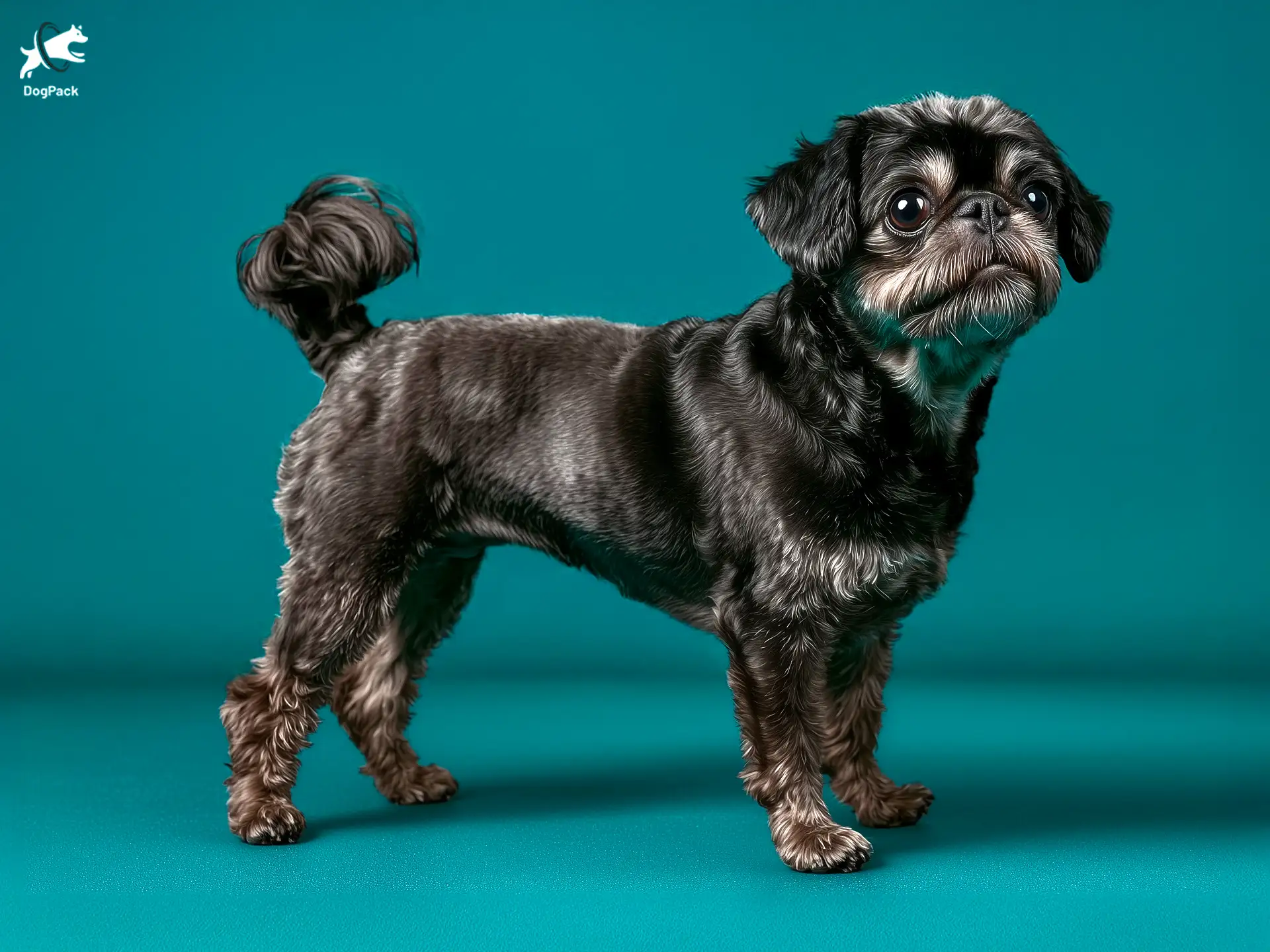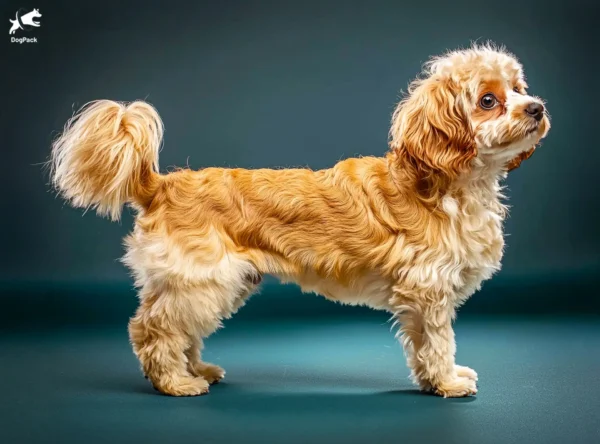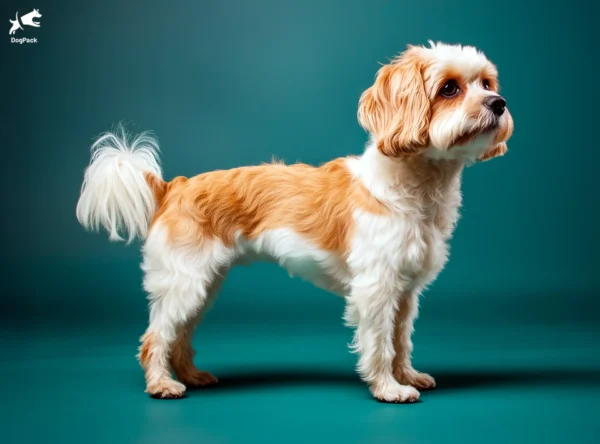Pugapoo Dog Breed Info & Overview
Are you ready to meet a pint-sized pup with big charm? The Pugapoo is a playful cross between the Pug and the Toy or Miniature Poodle. This cute companion thrives on snuggle time and adapts well to city or suburban homes. With a loyal nature and amusing antics, they bring endless laughter wherever they go, making every day brighter.
Characteristics
Pictures
Breed History
Long before the Pugapoo charmed dog lovers, both parent breeds had well-established histories. Pugs hail from ancient China, beloved by emperors for their lovable personalities and distinctive wrinkles. Toy and Miniature Poodles, on the other hand, have roots in Europe, where they excelled as agile water retrievers. The Pugapoo came about as a modern designer cross, seeking to combine the Pug’s comedic devotion with the Poodle’s intelligence.
According to anecdotal evidence, these hybrids began appearing in the United States over the last few decades. Breeders aimed to create a companion that was not only affectionate but also more hypoallergenic than the typical Pug. Because this mix is still relatively new, there is no official breed club. Nevertheless, the Pugapoo’s popularity has grown with families wanting a playful, people-focused companion.
My first encounter with a Pugapoo was at a local dog park, where a curly-tailed pooch was happily chasing tennis balls. The friendly owner explained how she fell in love with the breed’s goofy smile and curly coat, reflective of both parent breeds. Stories like this underscore how the Pugapoo excels as a modern family pet, bridging centuries of Pug and Poodle heritage into one pint-sized package.
Temperament, Personality
Many owners describe this mix as spirited yet sweet. They love being the center of attention and will hop onto your lap the moment you sit down. While they often inherit the Poodle’s cleverness, they also get the Pug’s happy-go-lucky nature, resulting in a dog that’s eager to please. In general, a Pugapoo thrives on human interaction and bonds quickly with every member of the household.
When it comes to other pets, early socialization makes a big difference. If introduced properly, they can coexist with cats or other small dogs cat-friendly dog breeds. This hybrid usually adores children and participates in lively games of fetch or gentle tug-of-war. Their main quirk is a constant desire for companionship, so they may follow you room to room, delighting in your presence.
Strangers are greeted with a mixture of curiosity and cautious friendliness. Once they decide someone is a friend, expect enthusiastic tail wags and a wagging butt to match. Some Pugapoos may inherit a slight stubborn streak from the Pug side, but consistent positive reinforcement helps them adapt. With the right approach, these dogs display a perfect blend of entertaining antics and well-mannered behavior.
Physical Characteristics
The Pugapoo typically stands around 10 to 13 inches at the shoulder, sporting a body that’s compact yet sturdy. Their faces often blend the Pug’s round muzzle with a slightly elongated snout from the Poodle side. Depending on genetics, they might showcase the endearing Pug wrinkles or a more streamlined face, striking a balance between the two parent breeds.
Coats vary from short and smooth to soft and curly, often in shades like fawn, black, or apricot. Many individuals inherit a slight curl from the Poodle while maintaining the Pug’s signature coloration. Ears tend to be floppy and triangular, adding to their charming, puppy-like appearance even in adulthood. Over time, owners may notice how their dog’s facial expressions communicate a surprising range of emotions.
The trademark curly tail can also emerge, though some Pugapoos have a straighter version. Their overall silhouette remains fairly small, making them easy to pick up for a quick cuddle. This petite physique also translates into lower space requirements than larger hybrids, an advantage for those living in small dog-friendly apartments. Ultimately, they boast a delightful mix of Pug’s adorableness and Poodle’s poise.
Health Issues
Like all hybrids, the Pugapoo may inherit health concerns from either parent breed. Respiratory issues can appear if the dog has a flatter face, similar to Pugs. Eye conditions, such as cherry eye or cataracts, also warrant watchfulness. Hip dysplasia and patellar luxation are possible too, especially if the Poodle side comes from lines prone to joint problems.
Regular veterinary checkups and screenings can help detect problems early. Maintaining a healthy weight is crucial, as carrying extra pounds can exacerbate breathing difficulties or joint stress. Selecting a breeder who performs relevant health tests on their stock helps reduce the risk of inheritable conditions. Checking with organizations like the Orthopedic Foundation for Animals can provide more insight into genetic testing.
My neighbor’s Pugapoo, Milo, once suffered from mild brachycephalic syndrome. With proactive medical care, including close monitoring and adjustments to his exercise routine, Milo bounced back. This example highlights the importance of attentive care for any potential issues. By staying informed, scheduling routine vet visits, and offering a balanced diet, you can help your Pugapoo live a vibrant, healthy life.
Grooming Needs
Grooming the Pugapoo often depends on whether they have a curlier or smoother coat. Those with more Poodle-like hair can be prone to matting, requiring regular brushing—about three times a week. A slicker brush or comb can help detangle knots, while occasional trims keep their fur manageable. Bathing every month or so is usually enough to maintain cleanliness.
If your dog leans toward the Pug’s short coat, grooming becomes simpler. Weekly brushing removes loose hair and stimulates healthy skin. Regardless of coat type, cleaning facial folds (if present) is essential to prevent irritation or infection. Keep an eye on any wrinkles and gently wipe them with a soft cloth as needed. Be mindful not to leave moisture behind.
Ears should be checked weekly for excess wax or signs of redness, as floppy ears can trap debris and moisture. Nail trimming and teeth brushing round out the routine. Dental care is particularly important, as small breeds are more prone to tartar buildup. Consistent grooming not only keeps your Pugapoo looking sharp but also promotes comfort and overall well-being.
Exercise Requirements
Despite their small size, Pugapoos do appreciate daily playtime. A short walk around the block plus some indoor fetch usually satisfies their energy needs. Because many inherit a bit of a brachycephalic structure, avoid strenuous exercise in hot or humid conditions. Watch for signs of overheating or labored breathing, pausing activities to let them rest and drink water.
A moderate approach is best. About 30–45 minutes of light to moderate exercise keeps them healthy without stressing their respiratory system. Interactive toys can also help burn energy indoors—puzzle feeders or treat-dispensing balls appeal to their inquisitive side. If your Pugapoo is more poodle-like, they may enjoy agility-style games, but always tailor intensity to your dog’s comfort level.
Don’t underestimate the mental stimulation aspect either. These dogs thrive when learning new tricks or playing hide-and-seek with treats. If you notice any reluctance to exercise, consult your vet to rule out underlying health issues. In general, a balanced routine ensures your Pugapoo remains at a healthy weight, supports joint health, and nurtures a happy, engaged mindset.
Training Tips
Patience and positivity are key when teaching your Pugapoo new commands. While the Poodle side often contributes intelligence, the Pug’s stubborn streak can appear. Use short, focused training sessions, reinforcing good behavior with treats or praise. If your dog seems disinterested, consider switching to a more engaging game. Reward-based methods typically yield the best results for this eager-to-please companion.
Socialization from puppyhood helps them feel comfortable around other dogs and diverse environments, reducing anxiety later. Introduce them to various noises, people, and animals. When they respond calmly, reward them. Consistency fosters confidence, so stick to a routine for feedings, walks, and bedtime. Avoid harsh corrections, as they can undermine trust and lead to anxiety-driven behavior.
Crate training can be beneficial, providing a secure den-like space for rest and relaxation. Offer chew toys to keep boredom at bay if you step out. If you need extra guidance, group obedience classes can help refine skills while giving your Pugapoo valuable interaction with other pups. Over time, you’ll see them develop polite habits that make everyday life more harmonious.
Nutrition, Diet
A Pugapoo’s diet should reflect its moderate energy level and potential for weight gain. Most adult dogs of this mix thrive on around ¾ to 1 cup of high-quality kibble per day, split into two meals. Consider a formula aimed at small or toy breeds, as their kibble size is easier to chew, and the nutrient density often suits a smaller dog’s metabolism.
Focus on a diet that supports joint health, especially if your pup leans toward the Poodle side. Look for glucosamine and chondroitin supplements or choose foods containing these ingredients. Because some Pugapoos have brachycephalic tendencies, keeping them lean can ease breathing. Monitor treats to avoid overfeeding—healthy snacks like baby carrots or apple slices can be a better choice than processed cookies.
If your dog is particularly active, consult your veterinarian for possible calorie adjustments. Keep fresh water available at all times to help them stay hydrated, especially in warmer climates. You might also explore rotating protein sources, like chicken or fish, to provide variety and balanced amino acids. Overall, tailoring portion sizes to your individual Pugapoo’s lifestyle supports optimal weight and energy levels.
Adoption, Breeders
If you’re considering adding this charming hybrid to your home, start by checking local shelters or rescue groups. Many organizations handle small designer dogs, offering a chance to give a deserving pup a new start. You can also explore specific rescue efforts geared toward Pug or Poodle mixes. Connecting with other owners through the Pugapoo Nation Facebook Group can also provide adoption leads and firsthand experiences with the breed.
For those seeking a breeder, ensure they conduct health tests on their breeding dogs—particularly for patellar luxation and brachycephalic conditions. A reputable breeder should welcome your questions about parent health certificates and living conditions. Ethical breeding ensures puppies are well-socialized, healthy, and raised in a nurturing environment. Researching responsible sources will help you bring home a happy, well-adjusted companion.
Beware of online listings offering “teacup” versions without proper documentation, as these dogs might be bred under questionable conditions. Ask for references from other families who have purchased puppies from the same breeder. Above all, prioritize ethical practices and a pup’s overall well-being. A little extra research ensures your new four-legged family member comes from a place committed to healthy, well-socialized dogs.
Family Pet?
Looking for a small dog that can fit seamlessly into family life? This mix often loves children and is gentle during play. Teaching kids to respect the dog’s boundaries fosters a harmonious environment. Thanks to moderate exercise needs, a quick backyard romp or short walk often suffices, making it easier to balance busy family schedules.
In multi-pet households, the Pugapoo’s social nature tends to shine, especially with gradual introductions. Because they thrive on companionship, they rarely turn down an invitation to join family gatherings or game nights. Patience is important if they show slight wariness at first—but with consistent positive interactions, they typically adapt to both new people and pets.
Friends of mine who have a Pugapoo say their children adore dressing up their furry pal in costumes, and the dog seems to love the attention. Lighthearted moments like these make family life special. If you’re searching for a cuddly, comedic companion who’s always game for a belly rub, it’s hard to go wrong with this cheerful hybrid.
Right For You?
Before committing to this fun-loving breed, consider if you have time for daily interactions. A Pugapoo can become restless or anxious when left alone for long periods. Small living spaces work fine, but mental stimulation through puzzle toys or short training sessions is essential. If you prefer a dog that happily curls up beside you while still being up for moderate play, this mix may be ideal.
Owners should be prepared for regular grooming, especially if the coat leans more toward the Poodle side. Additionally, be mindful of possible health challenges, from mild breathing difficulties to eye issues. Budgeting for vet care and grooming costs is wise. Families, seniors, or singles who want a sociable, comedic buddy will likely find that this hybrid checks most of their boxes.
On the other hand, if you’re often away from home and prefer a more independent dog, you might struggle to meet this breed’s need for closeness. Their outgoing nature could also be a handful for those craving a quiet household. Weigh these pros and cons carefully, so you and your new pal can enjoy a lifelong bond filled with tail wags and wet-nosed kisses.
Conclusion
Whether you’re looking for a playful friend to brighten your home or an affectionate companion to share cozy evenings, the Pugapoo could be an excellent match. Their blend of curiosity, devotion, and quirky charm creates a unique dog that fits well into many lifestyles. If you have the time and energy to keep them happy, this adorable hybrid may become your perfect sidekick.
FAQs
-
Do Pugapoos inherit the Pug’s breathing issues?
The Pugapoo can inherit the brachycephalic (flat-faced) features of the Pug or the longer muzzle of the Poodle. If they have a shorter snout, they may still experience breathing difficulties, but a longer Poodle-like muzzle can help reduce these risks.
-
Does a Pugapoo need more exercise than a Pug?
Yes! While Pugs are lower-energy, the Pugapoo is often more active due to the Poodle’s athleticism. They enjoy short bursts of play and regular walks but don’t require intense workouts. A daily 30–45 minutes of exercise is usually enough to keep them fit.
-
How does a Pugapoo’s coat type vary?
A Pugapoo’s coat can range from the short, smooth fur of a Pug to the curly, low-shedding coat of a Poodle. Some have wavy coats, requiring regular brushing, while others may inherit a more Pug-like coat, which sheds moderately.
-
Are Pugapoos better for allergy sufferers than Pugs?
Yes! The Pugapoo may be more allergy-friendly if they inherit the Poodle’s hypoallergenic coat. However, not all Pugapoos are completely hypoallergenic—some may still shed slightly, so spending time with the breed before adopting is recommended.
-
Do Pugapoos inherit the Pug’s stubbornness?
Pugapoos are intelligent yet occasionally stubborn. While Poodles are highly trainable, Pugs can be willful, making the Pugapoo a mix of both traits. Early training with positive reinforcement ensures they respond well to commands without developing stubborn tendencies.
Breed Ratings
The Pugapoo’s Poodle heritage boosts smarts, making training easier with consistent positive methods.
This mix loves games and often entertains with silly antics and a strong desire to join family fun.
Moderate bursts of energy are common, but they’re also content to lounge around in a cozy lap.
Depending on coat type, shedding can be minimal or moderate, but generally less than many other breeds.
Most Pugapoos don’t have a strong hunting instinct, though curiosity may lead them to chase smaller critters.
Some coats require regular brushing and occasional trims, but overall, grooming remains manageable.
With patience and treats, they pick up commands quickly, though a bit of stubbornness can appear.
Extended solitude can lead to anxiety or boredom; they flourish best with regular companionship.
They typically bark for attention or when excited but can be trained to moderate vocalizations.
Unlike some brachycephalic breeds, most Pugapoos have only minimal drooling.
Properly socialized individuals often get along well with other canines.
They can inherit issues from both parent breeds but are generally healthy with attentive care.













